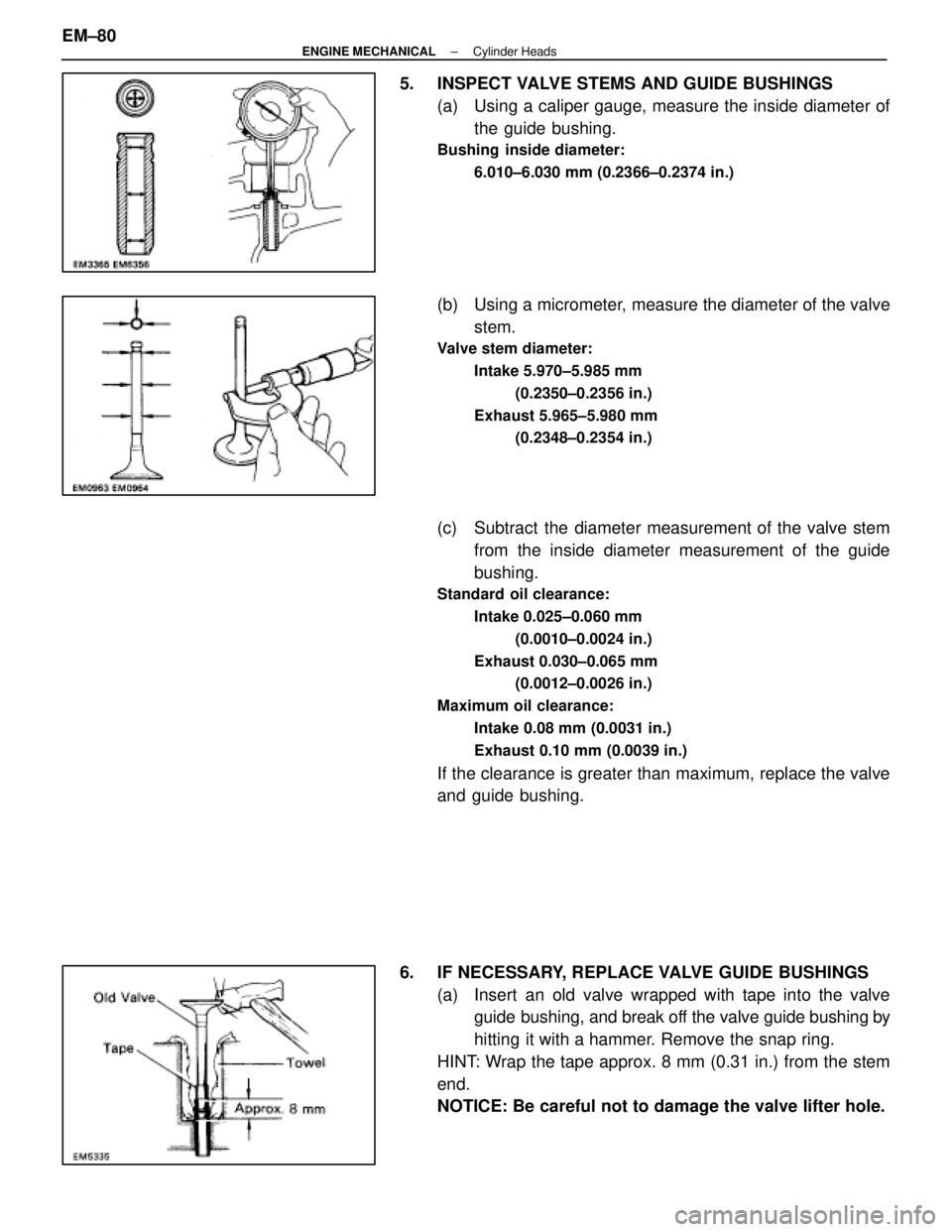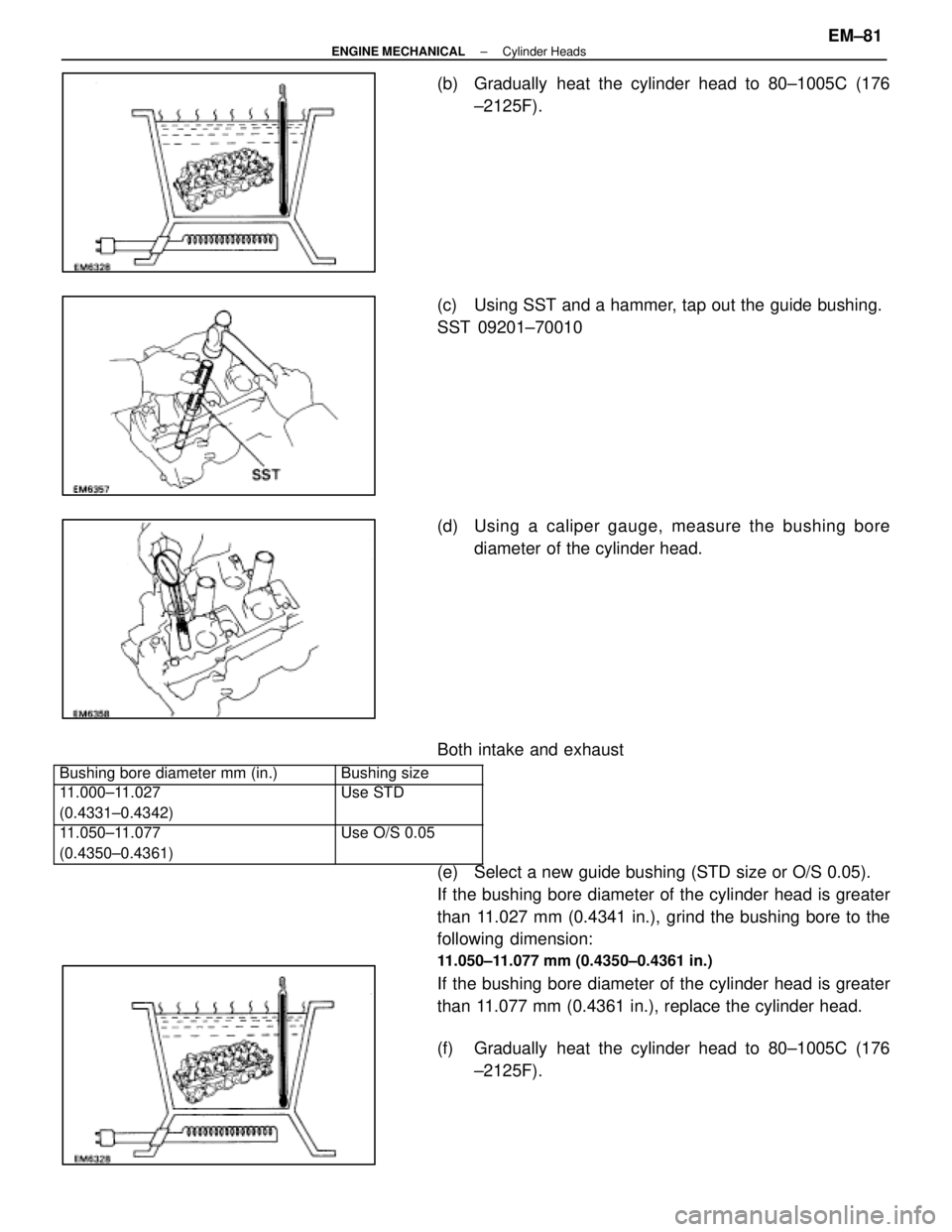Page 1776 of 4087
45. REMOVE CYLINDER HEADS(a) Uniformly loosen the ten cylinder head bolts on one side
of each cylinder head in several passes in the sequence
shown, then do the other side as shown. Remove the
twenty cylinder head bolts and plate washers.
NOTICE: Head warpage or cracking could result from re-
moving bolts in an incorrect order.
(b) Lift the cylinder heads from the dowels on the cylinder block, and place the two cylinder heads on wooden
blocks on a bench.
HINT: If the cylinder head is difficult to lift off, pry between the
cylinder head and cylinder block with a screwdriver.
NOTICE: Be careful not to damage the contact surfaces
of the cylinder head and cylinder block.
46. REMOVE EXHAUST MANIFOLD FROM RH CYLINDER HEAD
(a) Remove the three bolts and heat insulator.
(b) Remove the main oxygen sensor.
±
ENGINE MECHANICAL Cylinder HeadsEM±75
WhereEverybodyKnowsYourName
Page 1777 of 4087
(c) Remove the eight nuts, exhaust manifold and gasket.
47. REMOVE EXHAUST MANIFOLD FROM LH CYLINDER HEAD
(a) Remove the three bolts and heat insulator.
(b) Remove the main oxygen sensor.
(c) Remove the eight nuts, exhaust manifold and gasket.
DISASSEMBLY OF CYLINDER HEADS
(See Components on page EM±59)
1. REMOVE VALVE LIFTERS AND ADJUSTING SHIMS
EM±76
±
ENGINE MECHANICAL Cylinder Heads
WhereEverybodyKnowsYourName
Page 1778 of 4087
HINT: Arrange the valve lifters and adjusting shims in correct
order.
2. REMOVE VALVES (a) Using SST, compress the valve spring and remove thetwo keepers.
SST 09202±70010
(b) Remove the following parts: (1) Spring retainer
(2) Valve spring
(3) Valve
(4) Spring seat
HINT: Arrange the valves, valve springs, spring seats and
spring retainers in correct order.
(c) Using needle±nose pliers, remove the oil seal.
±
ENGINE MECHANICAL Cylinder HeadsEM±77
WhereEverybodyKnowsYourName
Page 1779 of 4087

INSPECTION, CLEANING AND REPAIR
OF CYLINDER HEAD COMPONENTS
1. CLEAN TOP SURFACES OF PISTONS AND CYLINDERBLOCK
(a) Turn the crankshaft and bring each piston to top deadcenter (TDC). Using a gasket scraper, remove all the
carbon from the piston top surfaces.
(b) Using a gasket scraper, remove all the gasket material from the top surfaces of the cylinder block.
(c) Using compressed air, blow carbon and oil from the bolt
holes.
CAUTION: Protect your eyes when using high±pressure
compressed air.
2. CLEAN CYLINDER HEADS
A. Remove gasket material Using a gasket scraper, remove all the gasket material from the cylinder block surface.
NOTICE: Be careful not to scratch the cylinder block con-
tact surface.
B. Clean combustion chambers Using a wire brush, remove all the carbon from the combus-
tion chambers.
NOTICE: Be careful not to scratch the cylinder block con-
tact surface.
C. Clean valve guide bushings Using a valve guide bushing brush and solvent, clean all the
guide bushings.
EM±78
±
ENGINE MECHANICAL Cylinder Heads
WhereEverybodyKnowsYourName
Page 1780 of 4087
D. Clean cylinder headsUsing a soft brush and solvent, thoroughly clean the cylinder
heads.
3. INSPECT CYLINDER HEADS
A. Inspect for flatness Using a precision straight edge and feeler gauge, measure
the surfaces contacting the cylinder block and manifolds for
warpage.
Maximum warpage: 0.10 mm (0.0039 in.)
If warpage is greater than maximum, replace the cylinder
head.
B. Inspect for cracks Using a dye penetrant, check the combustion chamber, in-
take ports, exhaust ports and cylinder block surface for
cracks.
If cracked, replace the cylinder head.
4. CLEAN VALVES (a) Using a gasket scraper, chip any carbon from the valvehead.
(b) Using a wire brush, thoroughly clean the valve.
±
ENGINE MECHANICAL Cylinder HeadsEM±79
WhereEverybodyKnowsYourName
Page 1781 of 4087

5. INSPECT VALVE STEMS AND GUIDE BUSHINGS(a) Using a caliper gauge, measure the inside diameter ofthe guide bushing.
Bushing inside diameter:
6.010±6.030 mm (0.2366±0.2374 in.)
(b) Using a micrometer, measure the diameter of the valvestem.
Valve stem diameter:
Intake 5.970±5.985 mm (0.2350±0.2356 in.)
Exhaust 5.965±5.980 mm (0.2348±0.2354 in.)
(c) Subtract the diameter measurement of the valve stemfrom the inside diameter measurement of the guide
bushing.
Standard oil clearance:
Intake 0.025±0.060 mm (0.0010±0.0024 in.)
Exhaust 0.030±0.065 mm (0.0012±0.0026 in.)
Maximum oil clearance: Intake 0.08 mm (0.0031 in.)
Exhaust 0.10 mm (0.0039 in.)
If the clearance is greater than maximum, replace the valve
and guide bushing.
6. IF NECESSARY, REPLACE VALVE GUIDE BUSHINGS (a) Insert an old valve wrapped with tape into the valveguide bushing, and break off the valve guide bushing by
hitting it with a hammer. Remove the snap ring.
HINT: Wrap the tape approx. 8 mm (0.31 in.) from the stem
end.
NOTICE: Be careful not to damage the valve lifter hole.
EM±80
±
ENGINE MECHANICAL Cylinder Heads
WhereEverybodyKnowsYourName
Page 1782 of 4087

(b) Gradually heat the cylinder head to 80±1005C (176±2125F).
(c) Using SST and a hammer, tap out the guide bushing.
SST 09201±70010
(d) Using a caliper g auge, measure the bushing bore
diameter of the cylinder head.
Both intake and exhaust
������������ ������������Bushing bore diameter mm (in.)������� �������Bushing size������������ �
�����������
������������
11.000±11.027
(0.4331±0.4342)������� �
������
�������Use STD
������������ �
�����������
������������
11.050±11.077
(0.4350±0.4361)������� �
������
�������
Use O/S 0.05
(e) Select a new guide bushing (STD size or O/S 0.05).
If the bushing bore diameter of the cylinder head is greater
than 11.027 mm (0.4341 in.), grind the bushing bore to the
following dimension:
11.050±11.077 mm (0.4350±0.4361 in.)
If the bushing bore diameter of the cylinder head is greater
than 11.077 mm (0.4361 in.), replace the cylinder head.
(f) Gradually heat the cylinder head to 80±1005C (176
±2125F).
±
ENGINE MECHANICAL Cylinder HeadsEM±81
WhereEverybodyKnowsYourName
Page 1783 of 4087
(g) Using SST and a hammer, tap in a new guide bushinguntil the snap ring makes contact with the cylinder head.
SST 09201±70010
HINT: Different the bushings are used for the intake and ex-
haust.
(h) Using a sharp 6 mm reamer, ream the guide bushing to obtain the standard specified clearance (See page
EM±80 ) between the guide bushing and valve stem.
7. INSPECT AND GRIND VALVES (a) Grind the valve enough to remove pits and carbon.
(b) Check that the valve is ground to the correct valve faceangle.
Valve face angle: 44.5 5
(c) Check the valve head margin thickness.
Standard margin thickness: 1.0 mm (0.039 in.)
Minimum margin thickness: 0.5 mm (0.020 in.)
If the margin thickness is less than minimum, replace the
valve.
EM±82
±
ENGINE MECHANICAL Cylinder Heads
WhereEverybodyKnowsYourName